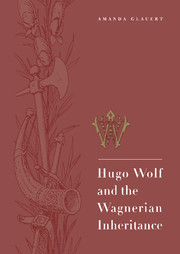Book contents
- Frontmatter
- Contents
- Acknowledgements
- Introduction
- 1 ‘Music of the future’? The nature of the Wagnerian inheritance
- 2 ‘Wagner of the Lied’? Wolf as critic of Wagner and Wagnerism
- 3 Small things can also enchant us – Wolf's challenge to nineteenth-century views of song
- 4 ‘Poetry the man, music the woman’? Wolf's reworking in his Mörike songs of Wagner's aesthetics of words and music
- 5 The integrity of musical language – questions of form and meaning in Wolf's Goethe songs
- 6 The Wolfian perspective – comparisons with the songs of Strauss and Mahler
- Notes
- Bibliography
- Index
6 - The Wolfian perspective – comparisons with the songs of Strauss and Mahler
Published online by Cambridge University Press: 31 October 2009
- Frontmatter
- Contents
- Acknowledgements
- Introduction
- 1 ‘Music of the future’? The nature of the Wagnerian inheritance
- 2 ‘Wagner of the Lied’? Wolf as critic of Wagner and Wagnerism
- 3 Small things can also enchant us – Wolf's challenge to nineteenth-century views of song
- 4 ‘Poetry the man, music the woman’? Wolf's reworking in his Mörike songs of Wagner's aesthetics of words and music
- 5 The integrity of musical language – questions of form and meaning in Wolf's Goethe songs
- 6 The Wolfian perspective – comparisons with the songs of Strauss and Mahler
- Notes
- Bibliography
- Index
Summary
Having looked at some of Wolf's songs in detail, and various aspects of his compositional approach, one begins to appreciate more why critics have been reluctant to embrace the full complexity of the music. For it would mean allowing elements of sceptical enquiry into the heart of lyrical song, where many have treasured thoughts of Wolf's music as a late flowering of Romanticism. The notion of Wolf measuring out a song's melodic and harmonic dimensions so that each moment can be placed precisely in relation to the whole, confirming or denying the processes of formal argument as they unfold, clashes uncomfortably with the image of lyricism inducing moments of pure forgertfulness. To many musicians, such experiences lie at the centre of the Lied as a genre and give it its special relationship with Romanticism. For in sensing the moment one glimpses the sublime, the freedom from rational boundaries of time and place, as surely as within the expanded dimensions of a Beethoven symphony.
Indeed for Wagner it was crucial that the two experiences of time should be seen to work together, the epic being released into an aura of timelessness by relaxing into moments of ‘pure lyricism’. As Carl Dahlhaus has observed, the notion of the leitmotif was itself based on a ‘suspension of time that flows’. But perhaps as important to the Ring's aspects of transcendence was the placing of the Rhinemaidens' simple melody at the beginning and end of its long narrative, as both a source and goal for all that happened in between.
- Type
- Chapter
- Information
- Hugo Wolf and the Wagnerian Inheritance , pp. 117 - 149Publisher: Cambridge University PressPrint publication year: 1999



